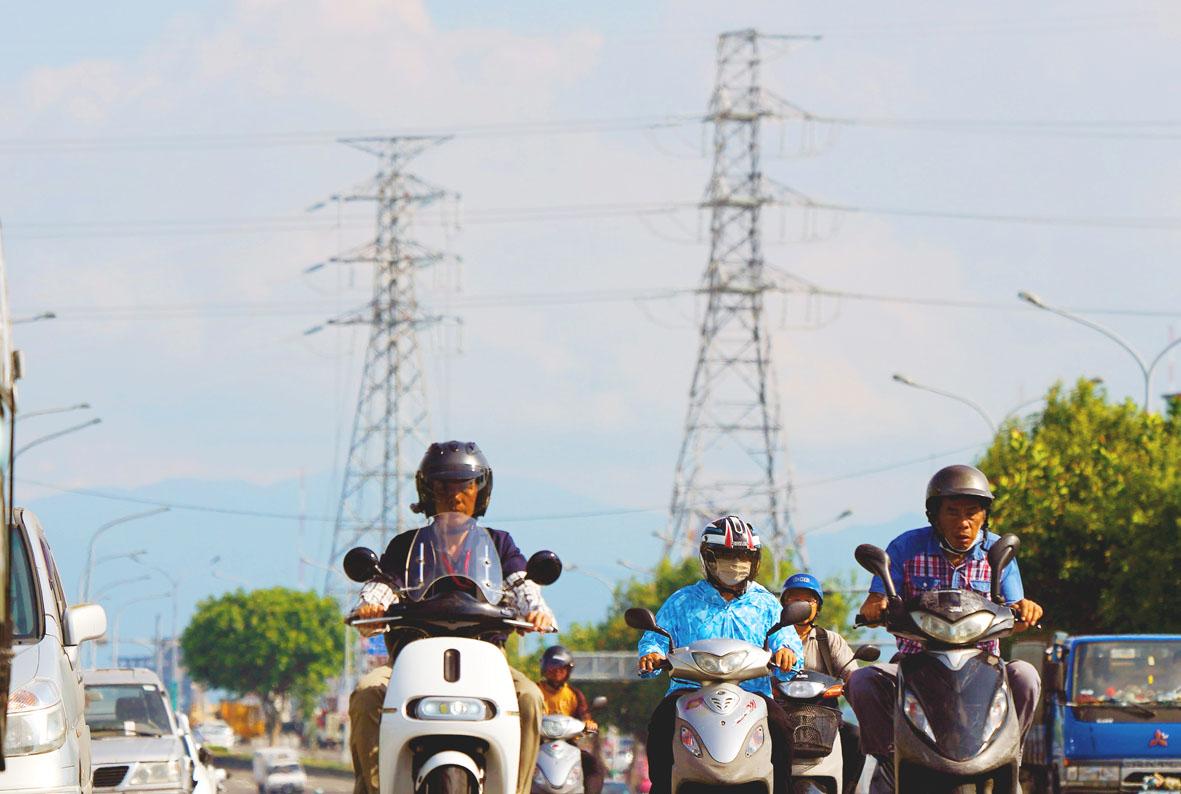Record heat is bringing record electricity use this month, after peak electricity consumption yesterday broke all historical records, Taiwan Power Co (Taipower, 台電) said.
As the mercury spiked close to 39°C, Taiwan’s electricity consumption reached as high as 37.79 gigawatts (GW) at 1:59pm yesterday, higher than the previous record of 37.53GW, seen just a day prior, the state-run utility said.
The top 10 peak consumption records have all occurred in the past three years, Taipower said.

Photo: CNA
As the high temperatures are likely to continue this summer, more records might be set, it said.
However, Taipower assured people that there is so far no need to worry about electricity shortages, despite the record-breaking demand, Taipower manager Chang Ting-shu (張廷抒) said.
“Our operating reserve margin is still 10.38 percent,” Chang told the Taipei Times by telephone, referring to the company’s “green” indicator.
The operating reserve margin is the amount of additional power that can be drawn from operational power plants to meet electricity demand in case a generator goes offline.
Taipower uses a five-color warning system to reflect the stability of the nation’s power supply, with “green” denoting an operating reserve margin of 10 percent or above and suggesting that the nation has an adequate supply of electricity.
“Yellow” means that the operating reserve margin is 6 to 10 percent, while “orange” signals a reserve margin of below 6 percent, “red” indicates less than 900,000 kilowatts and “black” less than 500,000 kilowatts.
Taichung Power Plant’s controversial No. 2 coal-fired generator was yesterday running at full capacity, the company said.
“We could not have done without it [No. 2 generator],” Chang said, adding that without the generator’s contribution of 0.55GW of electricity, the operating reserve margin would have fallen below 10 percent.
The Taichung City Government late last month fined Taipower for restarting the No. 2 generator, but the fine was later revoked by the Environmental Protection Agency.
Chang credited solar power for generating 2.13GW of electricity during peak usage, when it was needed most, saying that it accounted for 5.5 percent of total peak usage yesterday.
“Of course, the hotter it gets, the more electricity we use,” he said. “Fortunately, that is also when we get the most electricity from solar power generation.”
Wind power generation is strongest in winter, he added.

CAUTIOUS RECOVERY: While the manufacturing sector returned to growth amid the US-China trade truce, firms remain wary as uncertainty clouds the outlook, the CIER said The local manufacturing sector returned to expansion last month, as the official purchasing managers’ index (PMI) rose 2.1 points to 51.0, driven by a temporary easing in US-China trade tensions, the Chung-Hua Institution for Economic Research (CIER, 中華經濟研究院) said yesterday. The PMI gauges the health of the manufacturing industry, with readings above 50 indicating expansion and those below 50 signaling contraction. “Firms are not as pessimistic as they were in April, but they remain far from optimistic,” CIER president Lien Hsien-ming (連賢明) said at a news conference. The full impact of US tariff decisions is unlikely to become clear until later this month

With an approval rating of just two percent, Peruvian President Dina Boluarte might be the world’s most unpopular leader, according to pollsters. Protests greeted her rise to power 29 months ago, and have marked her entire term — joined by assorted scandals, investigations, controversies and a surge in gang violence. The 63-year-old is the target of a dozen probes, including for her alleged failure to declare gifts of luxury jewels and watches, a scandal inevitably dubbed “Rolexgate.” She is also under the microscope for a two-week undeclared absence for nose surgery — which she insists was medical, not cosmetic — and is

GROWING CONCERN: Some senior Trump administration officials opposed the UAE expansion over fears that another TSMC project could jeopardize its US investment Taiwan Semiconductor Manufacturing Co (TSMC, 台積電) is evaluating building an advanced production facility in the United Arab Emirates (UAE) and has discussed the possibility with officials in US President Donald Trump’s administration, people familiar with the matter said, in a potentially major bet on the Middle East that would only come to fruition with Washington’s approval. The company has had multiple meetings in the past few months with US Special Envoy to the Middle East Steve Witkoff and officials from MGX, an influential investment vehicle overseen by the UAE president’s brother, the people said. The conversations are a continuation of talks that

Alchip Technologies Ltd (世芯), an application-specific integrated circuit (ASIC) designer specializing in artificial-intelligence (AI) chips, yesterday said that small-volume production of 3-nanometer (nm) chips for a key customer is on track to start by the end of this year, dismissing speculation about delays in producing advanced chips. As Alchip is transitioning from 7-nanometer and 5-nanometer process technology to 3 nanometers, investors and shareholders have been closely monitoring whether the company is navigating through such transition smoothly. “We are proceeding well in [building] this generation [of chips]. It appears to me that no revision will be required. We have achieved success in designing